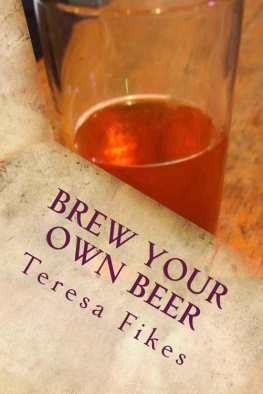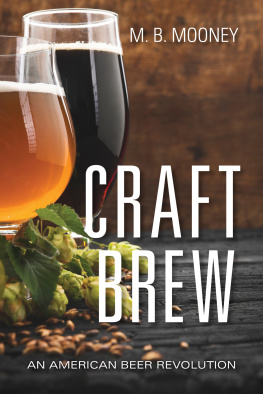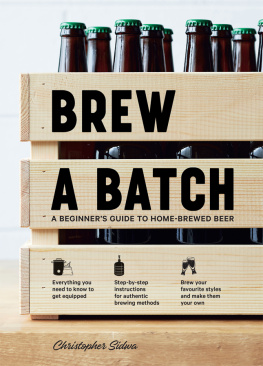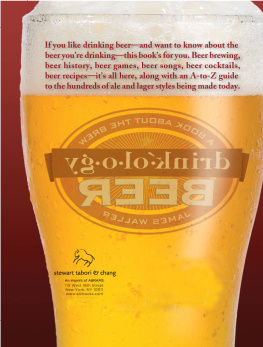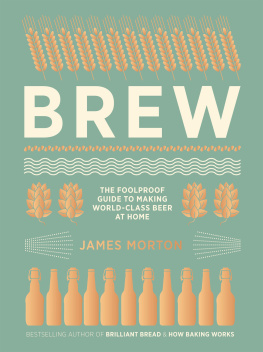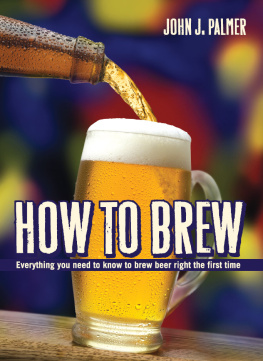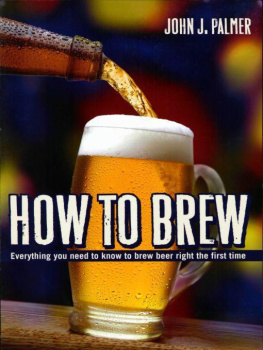Fikes - Brew Your Own Beer
Here you can read online Fikes - Brew Your Own Beer full text of the book (entire story) in english for free. Download pdf and epub, get meaning, cover and reviews about this ebook. year: 2014, genre: Home and family. Description of the work, (preface) as well as reviews are available. Best literature library LitArk.com created for fans of good reading and offers a wide selection of genres:
Romance novel
Science fiction
Adventure
Detective
Science
History
Home and family
Prose
Art
Politics
Computer
Non-fiction
Religion
Business
Children
Humor
Choose a favorite category and find really read worthwhile books. Enjoy immersion in the world of imagination, feel the emotions of the characters or learn something new for yourself, make an fascinating discovery.
- Book:Brew Your Own Beer
- Author:
- Genre:
- Year:2014
- Rating:3 / 5
- Favourites:Add to favourites
- Your mark:
- 60
- 1
- 2
- 3
- 4
- 5
Brew Your Own Beer: summary, description and annotation
We offer to read an annotation, description, summary or preface (depends on what the author of the book "Brew Your Own Beer" wrote himself). If you haven't found the necessary information about the book — write in the comments, we will try to find it.
Brew Your Own Beer — read online for free the complete book (whole text) full work
Below is the text of the book, divided by pages. System saving the place of the last page read, allows you to conveniently read the book "Brew Your Own Beer" online for free, without having to search again every time where you left off. Put a bookmark, and you can go to the page where you finished reading at any time.
Font size:
Interval:
Bookmark:
Brew Your Own Beer
Teresa L Fikes
Copyright 2014 Teresa L Fikes
All rights reserved.
ISBN:
ISBN-13:
DEDICATION
I would like to thank my husband for his patience and advice in writing this book. Without his help writing this book would not have been possible.
CONTENTS
Acknowledgments | |
The History of Beer | |
Popular Types and Flavors of Beer | |
Equipment for Brewing Beer at Home | |
The Four Basic Ingredients for Beer | |
Why the pH of Your Water is Important | |
Choosing the Yeast for Your Brew | |
Malts in Home Brewing | |
Choosing Hops for Home Brewing | |
The Initial Mix of a Home-Brewed Beer | |
Boiling Your Home Brew | |
Pitching the Yeast for Your Brew | |
Primary Fermentation | |
Racking the Beer | |
Secondary Fermentation | |
Selling Home Brewed Beer |
Acknowledgements
A special Acknowledgement goes to the great editor, Samantha Davis, for her help in making sure I have stay in line on the creation of this book
1 The history of Beer
Ancient Sumerian clay tablets show that the brewing of beer is as old as human civilization itself. Numerous deities were associated with ancient beer production, and all were female. This correlates with the accepted notion that the majority of Sumerian beer brewers were women. The earliest recipes called for soaking grains with bread and water, with the bread providing the yeast needed as the catalyst for the fermentation process.
Beer brewing continued with the Egyptian and Babylonian civilizations. Beer was a daily part of the diet of Egyptian Pharaohs and stonemasons alike. It played an important part in religious ceremonies and was also used to treat a variety of illnesses. The Babylonians had about 20 recipes for different types of beer. The Code of Hammurabi called for a daily ration of beer for Babylonian citizens according to their social standing.

http://upload.wikimedia.org/wikipedia/commons/thumb/0/0d/Beer_brewing_pot_of_Lobi_people%2C_Burkina_Faso.jpg/220px-Beer_brewing_pot_of_Lobi_people%2C_Burkina_Faso.jpg
Greeks learned the process of brewing from the Egyptians. The concept of drinking in moderation was introduced by Greek society. Sophocles that beer should be a part of every Greeks diet along with vegetables, breads, and meats.
The rise of Christianity also saw a rise in beer production. Monks played a significant role in brewing beer. They built breweries in the efforts to provide food, drink, and shelter to the poor, travelers, and religious pilgrims. The Catholic Church has recognized several saints as the patrons of beer making including St. Augustine of Hippo and Saint Luke "The Evangelist". Around 770 A.D., the Emperor Charlemagne is said to have personally trained many Christian brewers.
The taste of ancient beer hardly resembled the taste of beer today. Ancient brewers added all sorts of ingredients to the fermenting process such as herbs and spices, as well as odd ingredients like cheese and hallucinogens like poppy. The finished product was cloudy and filled with unfiltered sediments. The beer itself was a heavy liquid and did not have the head that is common with modern beers.
In 1516, it was the Duke of Bavaria ruled that the only ingredients in beer would be water, barley and hops, standardizing the process. Yeast was added to the process after it was discovered by Louis Pasteur in the mid-1800s. The beer-brewing process was a part of German law until formally repealed in 1987.
Further innovations in beer making took place during the Industrial Revolution. The invention of the thermometer and the hydrometer allowed brewers to observe and manage the process in more detail. The hydrometer was of particular importance. It allowed brewers to experiment with different malts and discover which ones produced the most flavorful beer.

https://c2.staticflickr.com/4/3592/3375658665_54406a80fd_z.jpg
The beer-brewing process is one that is interwoven between country traditions. Green beer is even a common tradition today on Saint Patricks Day. But Saint Patricks Day is more than just an excuse to drink. It is a Christian feast day that is observed by the Catholic, Anglican, Easter Orthodox, and Lutheran churches. St. Patricks Day commemorates the arrival of Christianity to Ireland and is recognized by the worldwide Irish diaspora as a day to celebrate Irish heritage and culture. St. Patricks Day celebrations feature the color green and Irish symbols such as shamrocks. The day also has earned a reputation for being a time when people consume mass quantities of beer - an odd reputation for a religious holiday. However, there is an interesting and little known reason for the association between beer drinking and St. Patricks Day.
Many centuries ago, The Church lifted the Lenten restrictions on eating meat and imbibing alcohol on St. Patricks Day. While the ultimate reason for the easing of these restrictions is unclear, many believe it was an acknowledgement by the Pope of the harsh living conditions the Irish endured under English rule. Legend has it, as the feast day occurs during a time when people have been abstaining from alcohol, there is a greater tendency to overindulge on this day. Hence, the tradition of getting drunk on St. Patricks Day.
The tradition of drinking green beer is believed to have started in Boston or New York City, both of which are home to significant Irish-American populations. Some believe it evolved from the Irish tradition of drowning the shamrock - dropping a shamrock into a glass of whiskey and consuming the whole thing, shamrock and all.

http://upload.wikimedia.org/wikipedia/commons/9/92/GreenBeer2.jpg
Modern beer making is a global industry. While some brewers are sticking to traditional techniques, many brewers are experimenting with new technologies and flavors. Advances in shipping and refrigeration have allowed regional breweries to reach an ever expanding global market. The modern consumer now has hundreds of choices of beers from all over the world.
2 Popular Types and Flavors of Beer
All beers are divided into two types - ales and lagers. While some beers combine the brewing processes associated with the two types, all beers can be distinguished by the kind of yeast that is used. Ale yeasts gather at the top of the fermentation tank and thrive at higher temperatures - 60 to 72 degrees. Lager yeasts work closer to the bottom of the tank and thrive at lower temperatures - 46 to 55 degrees. Ale yeasts ferment less aggressively than Lager yeasts, resulting in more sweetness and flavor.
After the fermentation process comes the aging process. Ales are aged for a few weeks at temperatures ranging from 40 to 55 degrees. Lagers are aged for months at much lower temperatures - 32 to 45 degrees. This results in lagers being cleaner and clearer than ales.
Within each type of beer are subcategories of different styles and varieties. Each style and variety differs from the others due to changes in the fermenting and aging processes. Different varieties of ales include Bitter, Pale Ale, Porter, and Stout. The varieties of lagers include Bock, Dry beers, and Pilsner.
Next pageFont size:
Interval:
Bookmark:
Similar books «Brew Your Own Beer»
Look at similar books to Brew Your Own Beer. We have selected literature similar in name and meaning in the hope of providing readers with more options to find new, interesting, not yet read works.
Discussion, reviews of the book Brew Your Own Beer and just readers' own opinions. Leave your comments, write what you think about the work, its meaning or the main characters. Specify what exactly you liked and what you didn't like, and why you think so.

